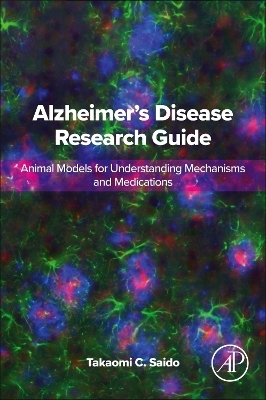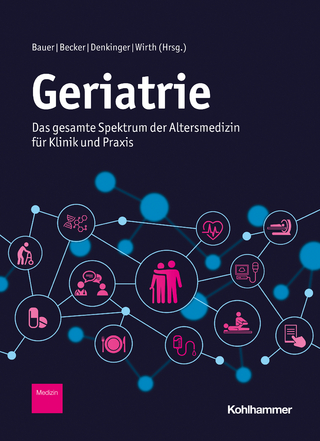
Alzheimer's Disease Research Guide
Academic Press Inc (Verlag)
978-0-443-28979-8 (ISBN)
Written by world renowned expert in Alzheimer’s research, this book is a valuable resource for all researchers.
Takaomi C. Saido is a graduate of Tsukuba University, Japan, where he majored in biophysics, and was subsequently trained in the Graduate School of Pharmaceutical Science, the University of Tokyo where he obtained PhD. During the graduate school years, he spent a year as a Visiting Scholar in the Department of Engineering and Applied Physics, Cornell University, NY. In the beginning of his career at the Tokyo Metropolitan Institute of Medical Science as a Research Scientist, he focused on proteolytic reactions conducted by calpain, a cytosolic calcium-activated neutral protease that modifies its substrates via limited proteolysis. His specialty was basic biochemistry, and he, for the first time in the history of proteolysis research, devised a universally applicable immunochemical method that can distinguish proteolytic products from the full-length substrates. The antibodies that created have been widely used in both basic and clinical studies worldwide (see a review, Saido et al., FASEB J, 1994). He then began collaborating with neurosurgeons and neuropathologists on brain ischemia and Alzheimer's disease (AD), respectively. The collaborations were so successful that in the 1990’s he decided to dedicate most of his time and effort to the study of the brain disorders as a Laboratory Head of RIKEN Brain Science Institute/Center for Brain Science. Although both brain ischemia (strokes) and AD cause dementia, the former had become more preventable by controlling vascular aging, whereas it has been still extremely difficult to stop the onset or to slow down the progression of AD, making him more inclined to study the latter. After discovering that amyloid b peptide (Ab) starting with pyroglutamate at positions 3 (AbN3pE) is a major species that accumulates in human brain (Saido et al., Neuron, 1995), he became interested in the catabolic mechanism of Ab. Using biochemical and reverse genetic methods, he discovered neprilysin (neutral endopeptidase) as a major in vivo Ab-degrading enzyme (Iwata et al., Nat Med, 2000; Science 2001). He hypothesized that an aging-dependent decline of neprilysin expression in the human brain may be one of the causes of sporadic AD. In the Science paper, he also predicted the possible presence of risk alleles in the MME gene encoding neprilysin, and a recent Genome-wide association study (GWAS) consistently identified two MME SNPs significantly associated with the incidence of sporadic AD (Bellenguez et al., Nat Genetics, 2022). In the course of identifying drug target(s) with specific emphasis on neprilysin, he discovered that binding of somatostatin to a somatostatin receptor heterodimer composed of subtypes 1 and 4 selectively increases neprilysin expression/activity (Saito et al., Nat Med, 2005; Saido et al. Japanese Patent 7099717, 2022), He now focuses on generating the GPCR-based medications that will be more specific/effective, safer, and more economical than immunotherapies for treating preclinical AD. His laboratory also created the world’s first single App knock-in mouse models that reconstitute AD pathology without depending on overexpression paradigm (Saito et al., Nat Neurosci, 2014); the models are being used by more than 800 groups worldwide. Consequently, he has become one of the highly cited scientists in the research community.
1. Introduction: Collaboration and Competition Together to Maximize the Velocity of Research and Development
2. Pathological Chronology and Pathological Biochemistry: The Beginning of The Beginning
3. Human Genetics: Establishment of Cause-And-Effect Relationships
4. Two Major Culprits: Amyloidogenic Aß And Non-Amyloidogenic Tau
5. Exact relationship between Aβ40 and Aβ42
6. Metabolism of Aβ: Catabolic and glimphatic systems
7. Biology of time: Temporal distance between cause and effect
8. 1st generation animal moβdels of Aβ amyoloidosis: Pros and cons of overexpression paradigm
9. Creation of single APPKNOCK-IN mouse models and of single MAPTNOKCK-IN models: Demonstration of AB-Tau axis
10. Application of Mouse Models to the experimental studies of AD
11. Neuroinflammation: Microgliosis and Astrocytosis in the days of microscopic omics
12. Central and peripheral nervous system, immune systems and digestive system: AD as a systemic disorder
13. Failure of more than 400 candidate medications in clinical trials before 2020
14. Therapeutic antibodies as a Wright brothers' airplane: Clinical proof-of-concept
15. Biomarkers for presymptomatic diagnosis and prognosis
16. Targeting somatostatin receptor heterodimer for developing safe, effective and ineffective and inexpensive medications
17. Application of genome editing to the treatment of familial AD
18. Identifying significant and insignificant publications: Prelude for chapter XIX
19. Journal of negative data for the days of generative AI-assisted publication
20. Conclusions
| Erscheinungsdatum | 21.08.2024 |
|---|---|
| Verlagsort | San Diego |
| Sprache | englisch |
| Maße | 152 x 229 mm |
| Gewicht | 460 g |
| Themenwelt | Medizin / Pharmazie ► Medizinische Fachgebiete ► Geriatrie |
| Naturwissenschaften ► Biologie ► Humanbiologie | |
| Naturwissenschaften ► Biologie ► Zoologie | |
| ISBN-10 | 0-443-28979-4 / 0443289794 |
| ISBN-13 | 978-0-443-28979-8 / 9780443289798 |
| Zustand | Neuware |
| Informationen gemäß Produktsicherheitsverordnung (GPSR) | |
| Haben Sie eine Frage zum Produkt? |
aus dem Bereich


